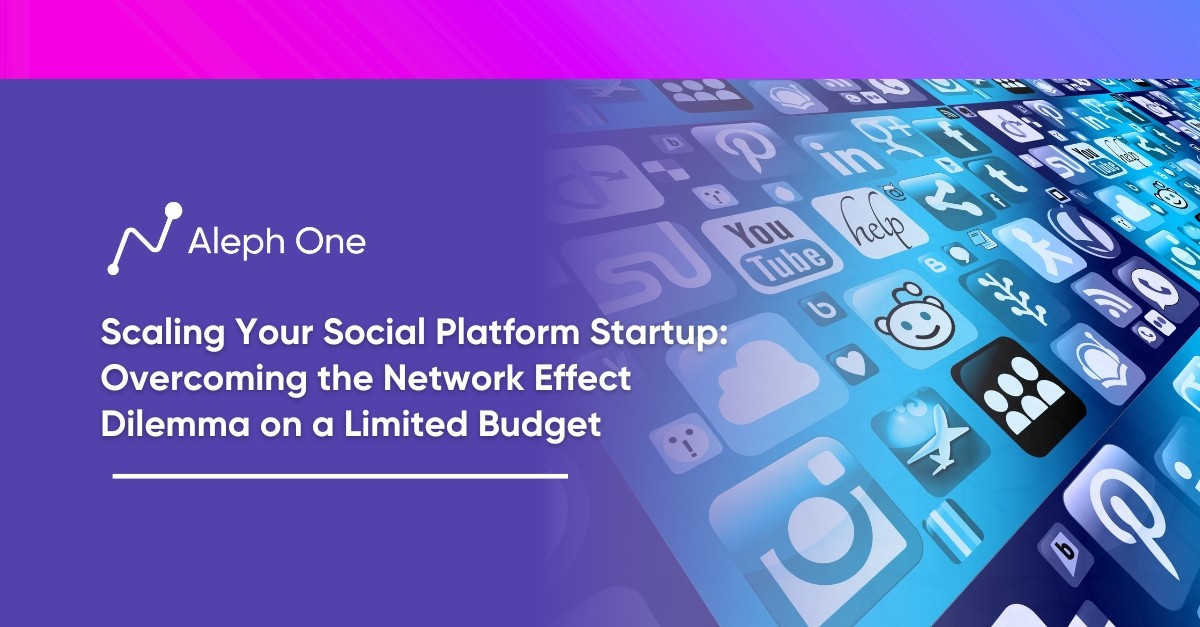Let’s work together to build something amazing. Share your project details and our team will reply to figure out the next steps to your success.

Building a social platform startup from the ground up is no easy task, especially when faced with the daunting “cold start problem.” This dilemma involves gathering enough initial users to make the platform valuable and encourage viral growth. The solution lies in harnessing the power of network effects, where a product’s value increases as more people use it. However, attaining network effects is an uphill battle starting with a small user base. This article explores social platform startups’ network effect dilemma and provides insights on overcoming it, even on a limited budget. By delving into growth hacking strategies, maximizing network effects, leveraging data analytics, expanding into new markets, and competing with tech giants, startups can chart a path to success in scaling their social platforms.

The Cold Start Problem: Why Network Effects Matter for Startups
For social platform startups, the early days of building a new product from scratch are filled with challenges. One of the biggest obstacles is overcoming the “cold start problem”—gaining enough initial users to make the platform useful and spur viral growth. This is due to the importance of network effects, where a product or service becomes more valuable as more people use it.
More Users Equate More Value
Network effects are challenging to achieve when you have few users. The more people join a new social network, the more value is created for all users. Without enough members, the network remains too small to provide real value. This results in a “catch-22”: you need more users to gain network effects but need network effects to attract more users.
Startups that Failed to Gain Network Effect Traction
Many promising startups have failed due to the inability to overcome the cold start problem. For example, the location-based social network Dodgeball gained early traction but ultimately shut down in 2005 before reaching critical mass. Friendster, an early social network that predated MySpace and Facebook, also needed to achieve more network effects to remain viable. The startup had over 3 million users at its peak but needed help adapting its platform to user needs changes, and growth stalled.
The good news is that the cold start problem can be overcome with enough creativity and perseverance. Some of today’s largest tech companies were once tiny startups that achieved exponential growth through network effects. But without a foundation of initial users, no amount of venture funding or media hype can spark real change. For social platform founders, the hard work comes in attracting dedicated users, understanding their needs, and building a platform that provides real value. With network effects, growth can be achieved on a limited budget by starting small, optimizing for engagement, and turning early adopters into evangelists. The cold start problem is challenging, but it can be solved.
Growth Hacking Your Way Past the Tipping Point
To overcome the cold start problem, startups must reach a “tipping point” of rapid adoption and growth. This is often achieved through innovative “growth hacking” strategies that spark viral loops and exponential growth.
Hotmail – From Zero to Over 1 Million Users
One of the earliest examples is Hotmail. When it launched in 1996, the founders included a simple footer at the bottom of every email that said, “Get your free email at Hotmail.” This created a viral loop, as each email spread the message to new potential users. Within months, Hotmail grew from zero to over 1 million users.
Airbnb – Online/Offline Strategy
Airbnb also leveraged growth hacking to overcome early challenges. When the founders first launched, they had rental listings but no bookings. They created a scrappy “online/offline” strategy. Online, they optimized their site for search engine traffic and posted listings on Craigslist. Offline, they contacted hosts in New York City and offered free professional photography for their listings. This combination of online and offline strategies led to their first bookings and growth.
Dropbox – Referrals and Social Sharing
Similarly, Dropbox grew through referrals and social sharing. They offered free storage space to both the referrer and the new user. This incentive and an easy-to-use product created viral loops as people shared Dropbox with friends and colleagues. The result was over 4 million users within 15 months of launch.
Today’s startups have even more tools for growth hacking. They can run social referral programs, leverage influencer marketing, optimize for social sharing, and more. But at their core, the strategies are the same: create a product that provides value, build in viral loops and incentives for sharing, then get creative in spreading the word to new users. With enough persistence, startups can achieve the tipping point of rapid growth and overcome the cold start problem through smart growth hacking.
Network Effects: Turning Users into Evangelists
For social platform startups, early adopters are the key to overcoming the cold start problem and reaching critical mass. But to achieve exponential growth, startups must turn these early niche users into mainstream evangelists for the platform. By maximizing “network effects”—the phenomenon where a product or service becomes more valuable as more people use it—startups can transform a small base of loyal users into a viral growth engine.
Gamification and Social Rewards
One of the most effective ways to maximize network effects is through gamification and social rewards. For example, Dropbox fueled early growth by offering free storage space to users who referred friends to the platform. This incentivized users to spread the word about Dropbox and bring their networks onto the platform. Startups like PayPal, Airbnb, and Pinterest also offered referral programs and social rewards to turn users into advocates.
Personalized Onboarding
Personalized onboarding is another crucial strategy. The faster startups can get new users engaged and connected, the more likely they will become regulars and spread the word. Duolingo, for example, onboards new users with a friendly chatbot that provides a tailored learning experience. This personal touch helps new users form an immediate emotional connection with the brand and become motivated to share it with others.
Advocacy and Social Sharing Should be a Seamless Experience
Finally, startups must make advocacy and social sharing a seamless part of the user experience. Adding social share buttons, notifications to invite friends and tools for users to build public profiles and share their activity on the platform can all spur social word-of-mouth growth. For example, fitness startup Strava grew through its highly social platform, where users can post workout achievements, share photos and stats, follow friends, join clubs, and cheer each other on. This made Strava into a community user who was passionate about spreading.
By maximizing network effects in these ways, startups can transform a small base of niche users into a viral growth engine to overcome the “cold start problem,” reach critical mass, and ultimately achieve mainstream adoption. The key is turning users into true evangelists who will spread the word about your platform.
The Power of Data: Using Analytics to Fuel Growth
For social platform startups, access to user data and analytics tools is crucial for overcoming growth ceilings. By analyzing metrics like user engagement, retention, and churn, companies can gain critical insights into opportunities for optimizing the user experience and accelerating growth.
Track Users Platform Use
For example, by tracking how long users engage with the platform and what causes them to drop off, startups can uncover areas of friction in the onboarding process or parts of the interface that need improvement. They can then run A/B tests to determine what changes increase stickiness and encourage more viral sharing. Metrics around social interactions, comments, likes, and shares can also reveal which types of content and features spark users’ enthusiasm.
Hotmail – Signature Strategy
Using data, Hotmail determined that users who set up email signatures referring friends to the service were the most viral. They optimized the onboarding process to encourage more users to set up such signatures, helping propel their growth. Similarly, Airbnb leveraged data showing that users with profile photos received many more bookings. They redesigned their platform to showcase photos more prominently and encourage all new members to upload pictures, strengthening network effects.
Tapping Into New Markets
For startups expanding into new markets, data is equally important. Analyzing how users in different countries engage with and share the platform can uncover key cultural insights and opportunities for localization. Music streaming startup Spotify used data to determine that playlists were viral in some markets but not others. They built region-specific playlist curation teams to boost engagement in new markets.
While data cannot solve all growth challenges, it is a compass to guide strategic decision making. With a steady stream of user data and the right analytics tools, startups can identify their highest potential growth levers and continually optimize to strengthen network effects, increase stickiness, and drive viral loops. With a data-driven growth strategy, even startups with limited resources can overcome network effect dilemmas and scale to new heights.
Overcoming the “Growth Ceiling”: Expanding into New Markets
While growth hacking and optimizing the user experience can help startups achieve initial success, many eventually hit a “growth ceiling” as they saturate their initial target market. To overcome plateaus in growth, startups must expand into new customer segments and geographic markets.
New Customer Segments
Expanding into new customer segments means adapting your platform to appeal to new types of users. For example, a social network targeting students may expand to young professionals, families, or older adults. This requires understanding the needs and behaviors of new segments and tailoring features and messaging to resonate with them. Partnering with organizations, influencers, and media platforms relevant to new parts can also help raise brand awareness and drive adoption.
Geographic Markets – Localizing the User Experience
Expanding into new geographic markets is also key to overcoming growth ceilings. This requires localizing the user experience for different cultures and languages. Things like currencies, date formats, color associations, and idioms should be adapted to regional preferences. Partnerships with local influencers, media, and organizations can help startups gain traction in new markets. Many startups launch in English-speaking countries before localizing to other major markets like China, India, and Brazil.
Twitch – Expanding Streaming Offerings
For example, live-streaming startup Twitch initially focused on gaming but expanded to include streams of music, cooking, and more. This expansion into new content segments fueled massive growth. Similarly, social giant Tencent expanded from China into India, Southeast Asia, and South America. By offering localized, culturally-relevant experiences in each market, Tencent overcame growth ceilings to become a global force.
Expanding into new customer segments and geographic markets is key to overcoming plateaus in growth and scaling startups into mainstream success stories. While growth hacking can achieve initial traction, true scale requires a commitment to understanding and appealing to diverse users worldwide. With cultural awareness and localization, startups can turn niche platforms into globally adopted networks.
Staying Ahead of Giants: How Startups Can Compete
As social platform startups achieve scale and success, more prominent tech companies will inevitably take notice and enter the space. While the resources and reach of giants can seem impossible, startups have vital advantages that allow them to compete and stay ahead.
Company Culture
The first is company culture. Startups often have an innovative, risk-taking culture that is hard for larger companies to replicate. This culture allows startups to make quick decisions, rapidly build and test new features, and pivot as needed to meet user needs. Even as they grow, startups that maintain this culture of innovation and speed have a competitive edge.
Startups Must be Flexible
Startups also benefit from flexibility. Lightweight, open, and modular platforms easily adapt to new use cases. This flexibility allows startups to customize experiences for niche segments and expand into adjacent markets. In contrast, the platforms of larger companies are often more rigid and difficult to change. Startups should focus on building flexible, scalable platforms that can evolve with user needs.
Strategic Differentiation
Finally, strategic differentiation is key. Startups must identify how their platform and user experience are truly unique. By highlighting these strategic differences, startups can attract loyal users and partners even in the face of larger competitors. The startup ClassPass, for example, scaled its fitness membership platform by focusing on providing a highly-curated experience with strong personalization and social features. This differentiated experience fueled ClassPass’s growth in the face of competition from larger companies.
Scale Your Social Platform Startup Successfully
While competing with tech giants is daunting, startups have key advantages that allow them to scale successfully. By maintaining a culture of innovation, building flexible platforms, and strategically differentiating their offering, startups can overcome challenges from larger competitors and continue growing their social platforms. With the right strategy and execution, startups can compete and win even on a limited budget.
FAQ
How do startups overcome the cold start problem to gain initial traction and create enough network effects?
Startups overcome the cold start problem and gain network effects by starting small, optimizing for engagement, and creatively driving user acquisition. They need to attract dedicated users and understand their needs to build a platform that provides real value. Initial building blocks include a quality product, inventive marketing, adaptable onboarding strategies, and creating a brand that generates loyalty. Some startups, such as Hotmail and Airbnb, used smart, simple “growth hacking” strategies to spark viral growth and attraction.
What are some of the most effective ways startups can maximize network effects to achieve exponential growth?
To maximize network effects and achieve exponential growth, startups can offer freebies for various user actions (referrals, social shares), personalized onboarding for a great first impression, and integrate social sharing mechanisms around their offerings. Dropbox, Airbnb, and PayPal successfully used referral program incentives to turn their users into advocates. Adding a social element to the user’s journey, such as public profiles, sharing features, and gamification, are effective ways to keep users engaged and motivated to share the platform.
What strategies can startups employ to compete and stay ahead when larger tech companies enter their space?
When faced with competition from larger tech companies, startups can use their innovative culture, flexibility, and strategic differentiation to their advantage. They can maintain a fast-paced environment conducive to spur-of-the-moment decisions, rapid feature rollouts, and quick pivots that larger companies may struggle to match. Moreover, they can build flexible, adaptable platforms easily contoured to fit new market requirements. By identifying unique selling points and strategic differences, startups can garner loyal users and partners. Being small allows them to experiment, innovate and offer unique experiences that are often difficult for larger entities. ClassPass successfully employed such strategies offering personalized and curated user experiences, unlike their bigger rivals.
Get the latest news and updates from Aleph One in your inbox.



